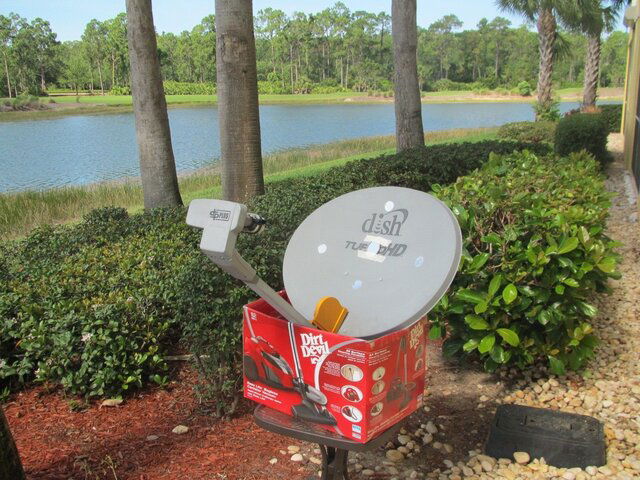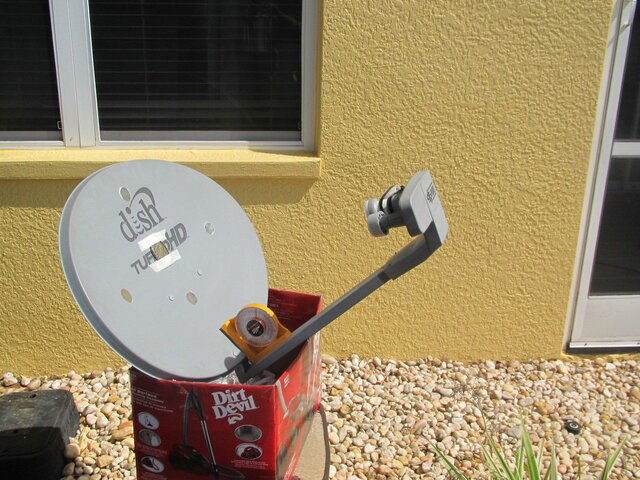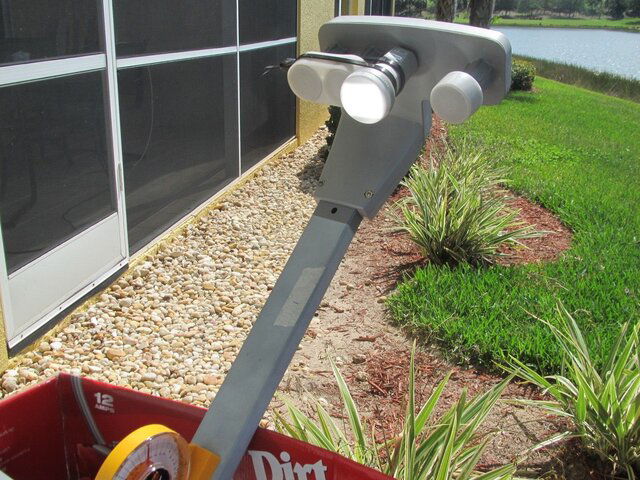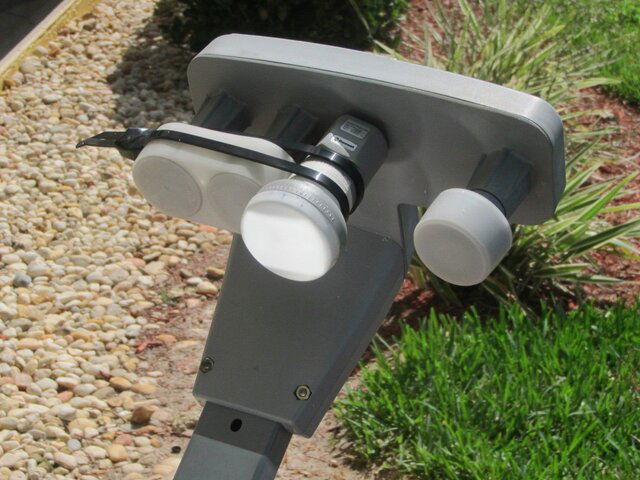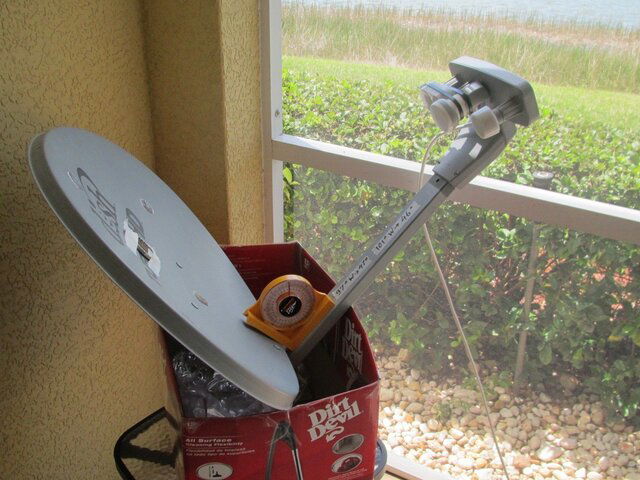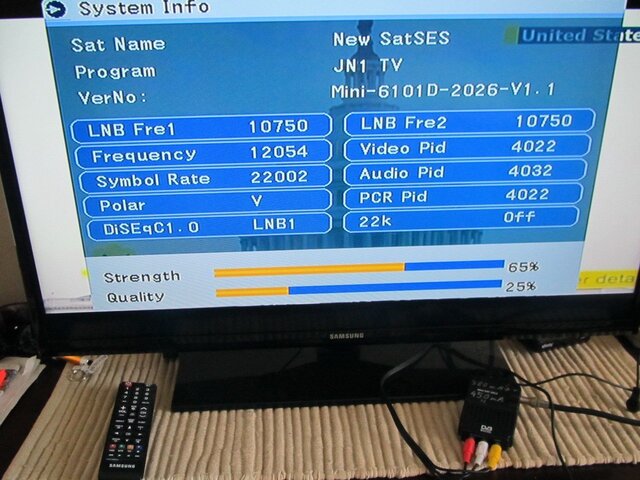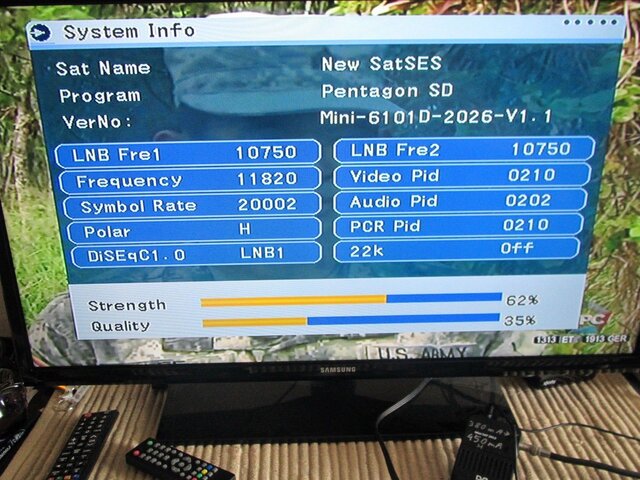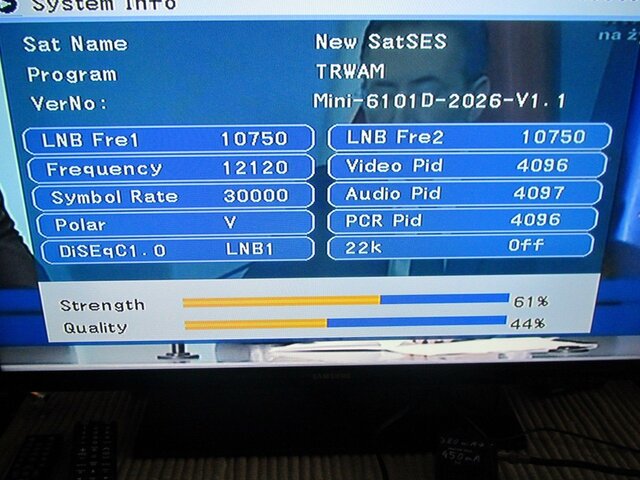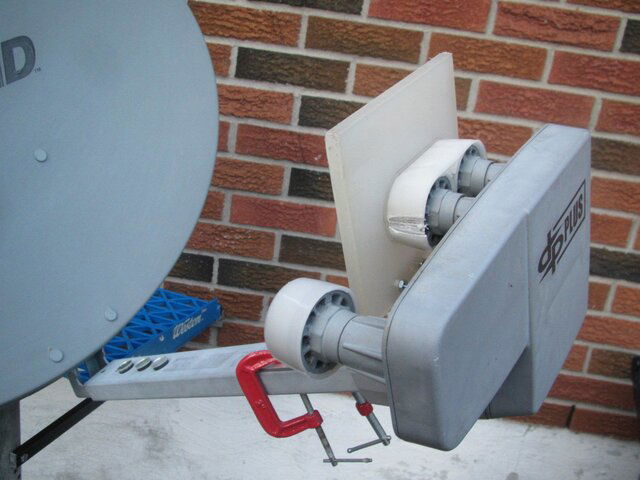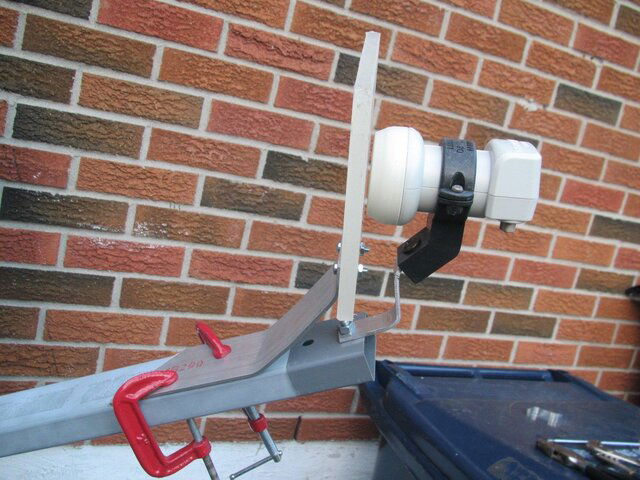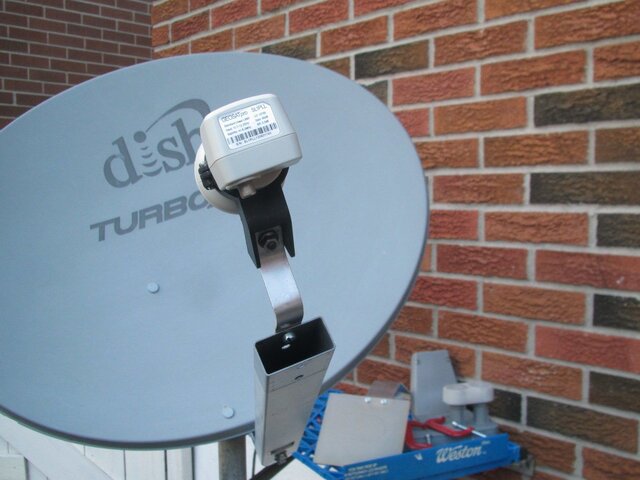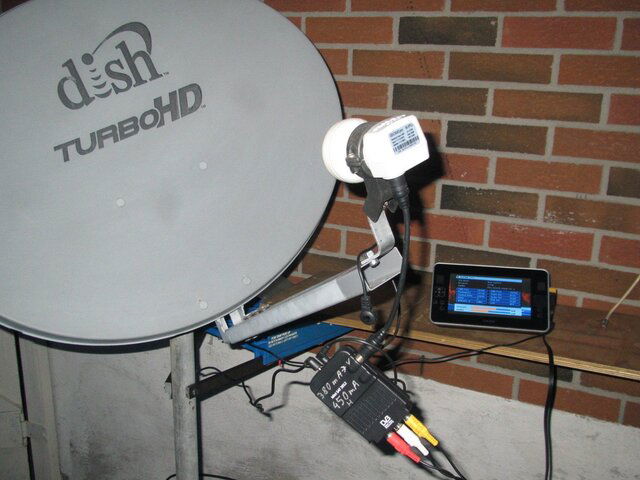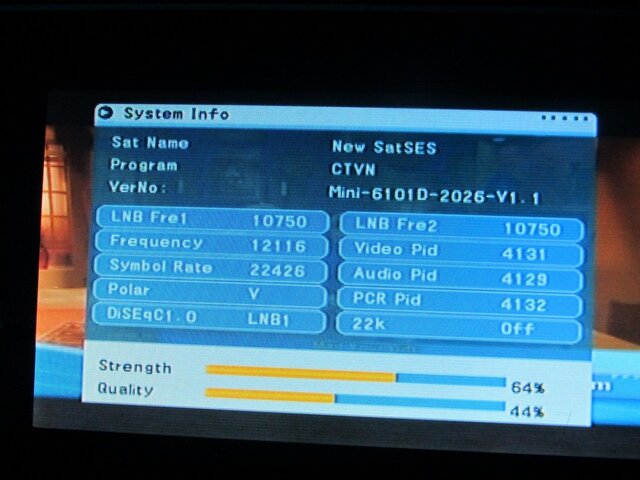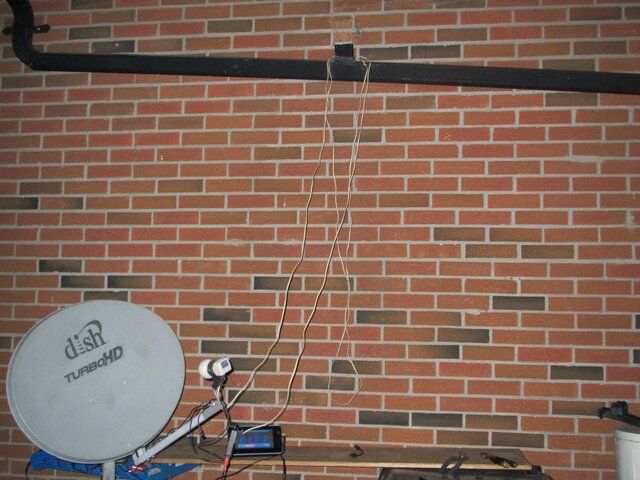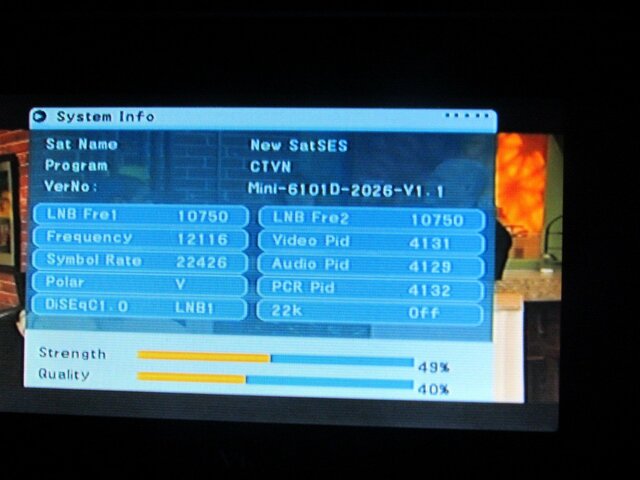Some pictures about trying to use Dish Turbo HD for receiving FTA from 97W and 101W
- Thread starter polgyver
- Start date
- Latest activity Latest activity:
- Replies 13
- Views 6K
You are using an out of date browser. It may not display this or other websites correctly.
You should upgrade or use an alternative browser.
You should upgrade or use an alternative browser.
- Status
- Please reply by conversation.
This is an example of what an experienced FTAer can do with the totally wrong dish! 
And not a recommendation (by me) to a newbie.
I like your inclinometer.
I like your mirrors.
I like your placement of the LNBF on the dish centerline.
I see how you moved the DishNet LNB assembly out to accommodate your own LNBF.
All very clever. Two thumbs up: :up :up
But I'm not sure how the cardboard box would stand up to the rain. lol
.
And not a recommendation (by me) to a newbie.
I like your inclinometer.
I like your mirrors.
I like your placement of the LNBF on the dish centerline.
I see how you moved the DishNet LNB assembly out to accommodate your own LNBF.
All very clever. Two thumbs up: :up :up
But I'm not sure how the cardboard box would stand up to the rain. lol
.
Thanks, Anole, for words of appreciation. Sharp-eyed expert, you noticed all what I tried to describe earlier and which was lost when I tried to add photos. We got invited for 2 week vacation with our long time Canadian friends, who own a condo in South-West Florida, in gated community, where no dishes are allowed in condos. During bicycle sightseeing this beautiful community, we could not find even one C-band dish, nor any true Ku dish, but we did find 5 dishes similar to my experimental one, attached to semi-detached or fully stand-alone homes, never at front wall, mostly on side walls.
As I was aware of this rules, I still decided to take my LNB and really small receiver, which I described earlier at this forum, Mini SAT 2012, just in case. The FTA addiction bug must be strong, because after 3 days there, I checked local Craigslist and asked my host to drive me 10 miles to buy this dish, which we bought for $ 30 (a new one is $ 170, at Sadoun's). First, I taped my LNB to the center one, but later, I made a notch in it and used tie-wraps.
I could not find the sats, so I used small mirror and US Navy site data to find proper Sun altitude and keep it with angle locator. Then the sats were found in a few minutes. My mistake was assuming wrong skew, but later I corrected it and got better quality. After accomplishing this, we took the dish apart and now it sits in my Toronto garage. Next project - trying to use its original 3 LNB's. Cheers, polgyver
As I was aware of this rules, I still decided to take my LNB and really small receiver, which I described earlier at this forum, Mini SAT 2012, just in case. The FTA addiction bug must be strong, because after 3 days there, I checked local Craigslist and asked my host to drive me 10 miles to buy this dish, which we bought for $ 30 (a new one is $ 170, at Sadoun's). First, I taped my LNB to the center one, but later, I made a notch in it and used tie-wraps.
I could not find the sats, so I used small mirror and US Navy site data to find proper Sun altitude and keep it with angle locator. Then the sats were found in a few minutes. My mistake was assuming wrong skew, but later I corrected it and got better quality. After accomplishing this, we took the dish apart and now it sits in my Toronto garage. Next project - trying to use its original 3 LNB's. Cheers, polgyver
One of the most comprehensive, creative, and clever mods I've seen posted in a long while! 
Now as to using the existing LNBs...
- you might come up with something creative with their spacing
- the diseqc switching in the head would probably work as-is
- inside each horn/throat is probably a metal vane; file it off to convert Circular to Linear
- but...
- some DishNet LNB assemblies pull a lot of current, so check before starting
- you're still stuck with the wrong LO frequency (it's DBS)
- DishNet hardware will be bandstacked, so be prepared to deal with it
The only mod I might add to your excellent work, would be to find a shorter LNBF.
That would save a bit of effort.
If you'll measure the existing feedhorn length, I'll check some short LNBFs and see if any would fit.
Some of the smaller ones are SatelliteAV single and dual output, and his new PLL model.
I have all of those on hand.
Now as to using the existing LNBs...
- you might come up with something creative with their spacing
- the diseqc switching in the head would probably work as-is
- inside each horn/throat is probably a metal vane; file it off to convert Circular to Linear
- but...
- some DishNet LNB assemblies pull a lot of current, so check before starting
- you're still stuck with the wrong LO frequency (it's DBS)
- DishNet hardware will be bandstacked, so be prepared to deal with it
The only mod I might add to your excellent work, would be to find a shorter LNBF.
That would save a bit of effort.
If you'll measure the existing feedhorn length, I'll check some short LNBFs and see if any would fit.
Some of the smaller ones are SatelliteAV single and dual output, and his new PLL model.
I have all of those on hand.
I guess the length of the LNBF no longer matters with your new bracket.
You might find a buyer for the 3-horn DishNet LNB assembly.
If you could recoup $10-15-20, that would probably be wiser than cutting it open.
You might find a buyer for the 3-horn DishNet LNB assembly.
If you could recoup $10-15-20, that would probably be wiser than cutting it open.
Many of us have come up with various brackets to hold LNBFs.
It was strapping yours to an existing off-center feedhorn that caught my attention.
Still don't know how long the Dish feedhorns are, and whether a short LNBF might fit without moving the existing cluster away from the dish.
Anyway, here're the lengths of several popular GeoSatPro Standard LNBFs:
...SL2 - 5 1/8"
...SL1 - 3 5/8"
SL1pll - 3 7/8"
Dont know of any shorter than the SL1.
.
It was strapping yours to an existing off-center feedhorn that caught my attention.
Still don't know how long the Dish feedhorns are, and whether a short LNBF might fit without moving the existing cluster away from the dish.
Anyway, here're the lengths of several popular GeoSatPro Standard LNBFs:
...SL2 - 5 1/8"
...SL1 - 3 5/8"
SL1pll - 3 7/8"
Dont know of any shorter than the SL1.
.
I did not dare to cut open the original 3-LNBF head yet, but installed one good LNBF and started investigating another idea : replacing RG-6 with ordinary unshielded telephone wire (24' long), which still allowed reception, although with much lower Strength and Quality View attachment 87416View attachment 87417View attachment 87418View attachment 87419View attachment 87420View attachment 87421View attachment 87422View attachment 87423View attachment 87415
Telephone wire?!?
Telephone wire?!?And it WORKS! Holy crap!
It's just impedance and shielding. Try some old TV ladder wire, twinlead or Cat 5 with baluns. It all works, just a matter of how long of run.
Many of us have come up with various brackets to hold LNBFs.
It was strapping yours to an existing off-center feedhorn that caught my attention.
Still don't know how long the Dish feedhorns are, and whether a short LNBF might fit without moving the existing cluster away from the dish.
Anyway, here're the lengths of several popular GeoSatPro Standard LNBFs:
...SL2 - 5 1/8"
...SL1 - 3 5/8"
SL1pll - 3 7/8"
Dont know of any shorter than the SL1.
.
Hi, Anole, I have a few LNBF's, which are 3-5/16" long, but they are still too long, as the original assembly needs a LNBF 2-3/4 " - and probably such device does not exist. Therefore using existing assembly with an added LNBF is not feasible. I took apart the assembly and made some photos of it, but am not sure if anybody would be interested to see them. If the assembly is to be used only for holding an extra LNBF, then there is another place to extend its location: it is the connection of the bar to the "V" bracket under the dish (needs an extra hole drilled in the bar). Cheers, polgyver


So what exactly are the mirrors for? I'm new and still learning.
Mirror imitates (with visible light) what dish does with microwaves coming from satellites. It can help with altitude setting - providing you are familiar with Navy site which supplies you with data regarding positions of Sun (or, Moon). If you need altitude setting for your satellite, say, for example, 36.4 degree, and you do not trust or can not use the altitude markings on the dish bracket, you can attach (using masking or duct tape) small mirror to the dish, anywhere, but it is easier in the centre, and wait until Sun reaches this altitude (which you should determine earlier using Navy site). In summer, this is possible in the morning and in the afternoon. In winter, when the Sun goes below the satellite arc, you can only test the markings. Of course, the dish should be turned around its pole to get the reflected light on the LNB at this pre-determined hour and minute.
If you get more confident in using this method, you can even determine the location of focal point of a dish without its original LNB bracket - but this requires using more mirrors. These can be easily bought in dollar stores. Their diameter should be from half inch to one inch. A small screen, movable, should be attached to the end of LNB bar. It is possible to use small mirrors glued to small round magnets, to check distortion of metal dish bowl. Cheers, polgyver
Actually, the pertinate info in this thread is the clever use of the plastic sheet bolted/clamped so it touches the existing LNBF.
He drew a line on the sheet to indicate where to put the new LNBF.
That solves multiple problems you can run into:
- height of LNBF from arm
- distance of LNBF from dish
- angle (aiming) of LNBF to dish center
and of course, you want your replacement LNBF to be on the centerline oh the arm. :up
?.
He drew a line on the sheet to indicate where to put the new LNBF.
That solves multiple problems you can run into:
- height of LNBF from arm
- distance of LNBF from dish
- angle (aiming) of LNBF to dish center
and of course, you want your replacement LNBF to be on the centerline oh the arm. :up
?.
- Status
- Please reply by conversation.
Similar threads
- Replies
- 8
- Views
- 1K
- Replies
- 20
- Views
- 817
- Replies
- 1
- Views
- 808
- Replies
- 301
- Views
- 19K
Users Who Are Viewing This Thread (Total: 0, Members: 0, Guests: 0)
Who Read This Thread (Total Members: 1)
Latest posts
-
LWill The Steam Frame BEAT These VR Headsets - I’ve Tried them All
- Latest: Linus Tech Tips
-
-


